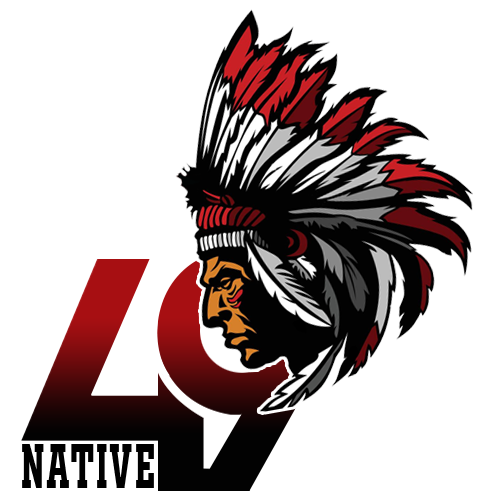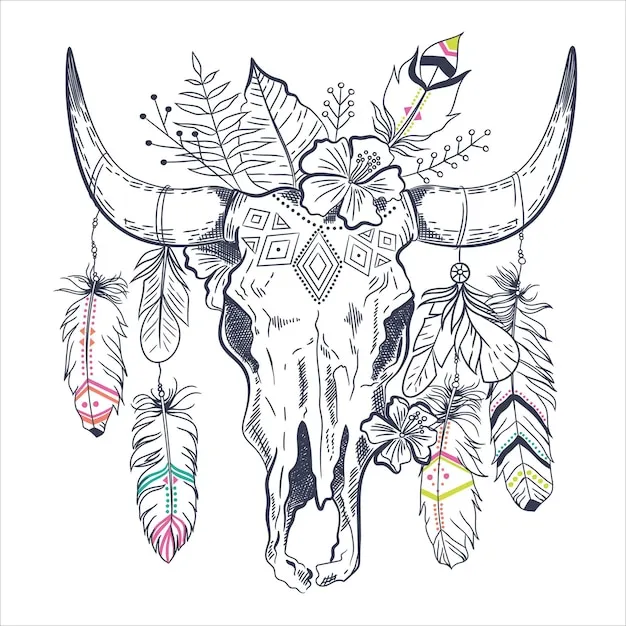What Is Native American Bull Skull Tattoos? In the realm of Native American tattoo artistry, one symbol stands tall and resolute—the bull skull. These striking emblems, intricately etched onto the skin, hold profound significance within indigenous societies.
Join 49native on a journey to unravel the mysteries and meanings woven into the fabric of Native American bull skull tattoos.
What does a tribal bull skull mean?
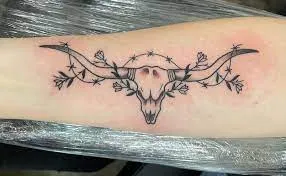
Bull Skull Tattoos are not merely inked images; they are profound symbols that embody strength, courage, and the intricate dance between life and death. In this journey of symbolism and meaning, we unravel the spiritual depth of the bull skull tattoo, shedding light on its significance that spans across various cultures.
Whether you seek to manifest personal traits or simply appreciate the artistry, the bull skull tattoo offers a canvas of symbolism waiting to be explored.
Bull Skull Tattoo: A Fusion of Meanings
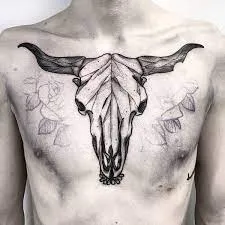
At the heart of the bull skull tattoo lies a fusion of meanings, blending the individual symbolism of both the bull and the skull. Each element contributes to a tapestry of significance, ultimately tailored to the wearer’s interpretation.
The Symbolism of the Bull
The bull, a majestic and powerful creature, serves as the focal point of the tattoo’s symbolism. Within its sturdy frame and resolute gaze, the bull embodies a multitude of virtues:
- Power: The bull exudes raw power, symbolizing an indomitable force that can overcome challenges.
- Strength: Its robust physique signifies physical and emotional strength, a testament to resilience in adversity.
- Agility: Despite its imposing presence, the bull possesses surprising agility, reminding us of the importance of adaptability.
- Courage: The bull’s fearless nature is synonymous with courage, inspiring us to confront life’s trials head-on.
Your bull skull tattoo may encapsulate some or all of these qualities, reflecting the facets of your character or aspirations. Whether you choose it for its symbolism or artistic allure, this tattoo is a canvas of self-expression.
The Significance of the Skull
The skull, a universal symbol of mortality, complements the bull’s attributes, adding depth to the tattoo’s meaning. It serves as a reminder of the natural life processes and the transient nature of existence. In the context of the bull skull tattoo, it underscores the fragile balance between strength and vulnerability.
A Shield Against Malevolence: Native American Perspective
In Native American culture, the bull skull assumes a protective role, believed to ward off evil spirits and bestow good luck upon its possessor. It resonates with the spiritual realm, becoming a talisman of safeguarding against malevolence. This ancient belief adds an additional layer of symbolism to the bull skull tattoo, imbuing it with a sense of guardianship and positivity.
The bull skull tattoo is a versatile emblem, reflecting a spectrum of meanings, from personal traits to cultural beliefs. Its enduring symbolism invites wearers to explore and embrace the values and ideals it represents, making it not just a tattoo but a profound statement of identity and spirituality.
What does the buffalo skull tattoo mean?
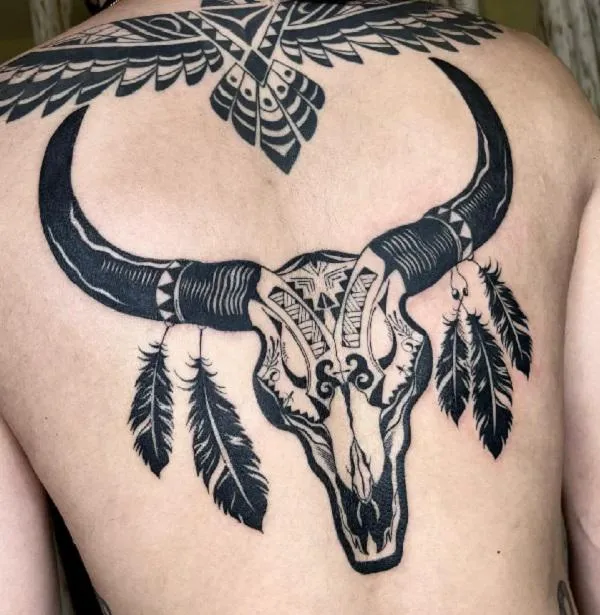
The buffalo, also known as the North American Bison or Tatanka, stands as an iconic symbol deeply woven into the tapestry of Native American culture. Within the heart of North America, this majestic creature has held a position of honor and reverence, offering sustenance, protection, and spiritual significance to the indigenous peoples. In this exploration, we delve into the profound symbolism and enduring legacy of the buffalo.
The Buffalo: A Source of Abundance
The buffalo’s significance in Native American tribes extends far beyond its imposing physical presence. It is a symbol of abundance, embodying the idea of provision and plenty. For generations, indigenous communities relied on this magnificent animal for their very survival. The buffalo provided:
- Food: Its meat was a vital source of sustenance, supplying nourishment to countless families.
- Clothing: Buffalo hides were transformed into warm clothing, protecting against the harsh elements of the North American plains.
- Shelter: Buffalo hides also played a pivotal role in constructing durable and weather-resistant dwellings.
- Tools: Bones and horns from the buffalo were fashioned into tools, aiding in daily tasks and craftsmanship.
- Medicine: Various parts of the buffalo, such as organs and bones, held medicinal value and were used in traditional healing practices.
The Symbolism of Strength and Stability
Beyond its practical contributions, the buffalo embodies qualities of strength and stability. Its colossal frame, unwavering presence, and resilience in the face of adversity make it a powerful symbol of these virtues. The buffalo’s ability to thrive in the harshest of environments serves as an inspiration, reminding us of the importance of unwavering determination.
A Medium for Sacred Rituals
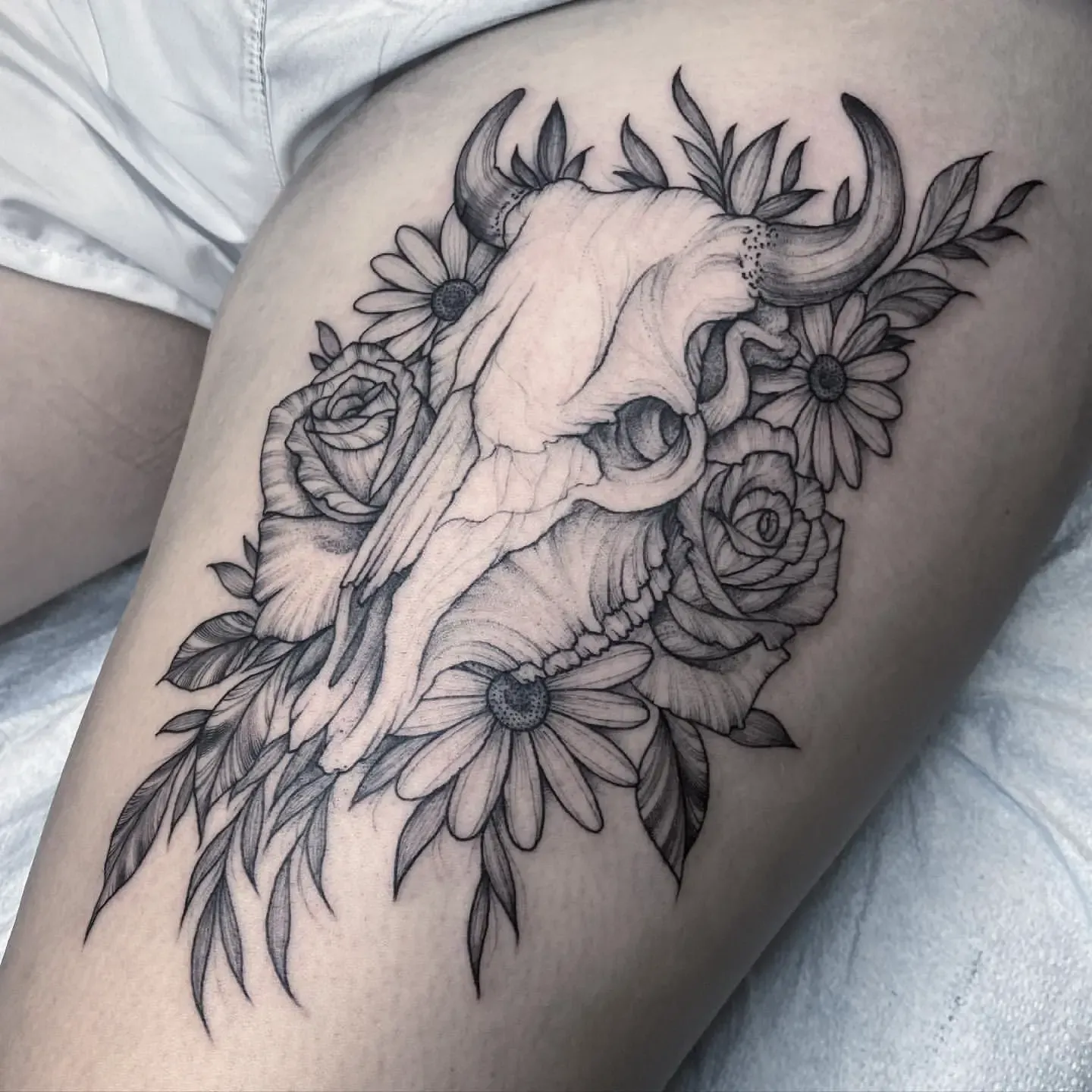
See more: Intriguing Exploration Of Native American Skull Tattoo Designs
In the Lakota way of life, the buffalo’s skull held particular significance. It was employed as a medium for prayers and communication with Wakan Tanka, often translated as “The Divine.” These sacred rituals were conduits for spiritual connection, seeking blessings and guidance from the divine realm. The buffalo’s skull, with its intrinsic link to life and sustenance, became a symbol of reverence and spiritual communion.
Guardian of Homes and Tradition
Native American communities also displayed buffalo skulls outside their homes. This served a dual purpose: it provided information about the inhabitants inside, their tribe, and their way of life, while also acting as a protective talisman. The buffalo‘s presence was believed to safeguard the home and its occupants from harm.
A Timeless Symbol
Even in modern times, the buffalo retains its revered status among American Indian tribes who diligently preserve their traditional ceremonies. It stands as a timeless symbol, bridging the gap between ancient traditions and contemporary life, reminding all who encounter it of the enduring connection between humanity, nature, and the divine.
The buffalo’s symbolism in Native American culture transcends the boundaries of time and continues to be a source of inspiration and reverence. Its legacy as a symbol of abundance, strength, and spiritual connection serves as a testament to the profound relationship between indigenous peoples and the natural world.
What does a Native American chief skull tattoo mean?
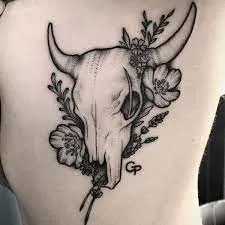
Indian Skull Tattoo Meaning
Indian skull tattoos are a mesmerizing tapestry of cultural richness and symbolism that vary from tribe to tribe, weaving a narrative of respect, pride, leadership, loyalty, and heritage. In this exploration, we embark on a journey to unravel the profound meanings behind these captivating tattoos that encapsulate the essence of Native American heritage.
Respect, Pride, and Leadership: The Core Symbolism
At the heart of Indian skull tattoos lies a potent symbol of respect, pride, and leadership. These tattoos pay homage to the indomitable spirit of Native American warriors and leaders who embodied these virtues. The skull, often adorned with elaborate headdresses, serves as a visual testament to the fierce determination and unwavering pride that defined these remarkable individuals.
Loyalty and Heritage: An Unbreakable Bond
Loyalty and heritage are threads that intricately weave through the fabric of Indian skull tattoos. Each stroke of ink on the canvas of skin speaks of a deep-rooted loyalty to one’s tribe and ancestors. These tattoos stand as a living testament to the enduring connection that Native Americans maintain with their cultural heritage.
The Power of Colorful Headdresses
A hallmark of popular Indian skull tattoos is the inclusion of bright and colorful headdresses adorned with large feathers. These vibrant plumages are not merely decorative; they carry profound symbolism.
They represent the fierceness and intensity of the warrior being depicted. Each feather is a badge of honor, earned through acts of valor and resilience. The cultural connection to a specific tribe is elegantly conveyed through these intricate headdresses, making them a perfect symbol of the indomitable spirit of Native American tribes.
A Darker Undertone: Resilience Amid Struggle
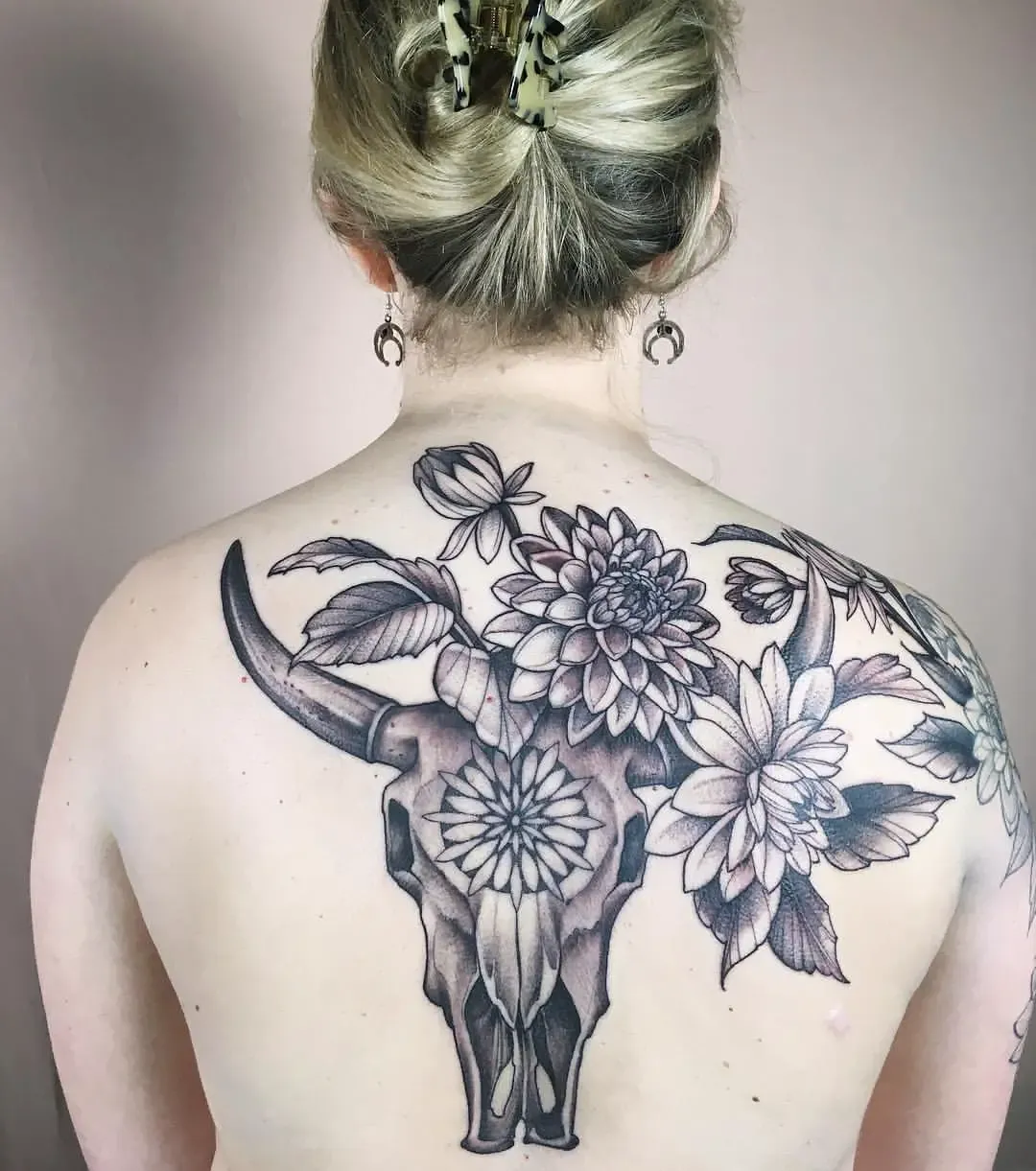
Beyond their aesthetic allure, Indian skull tattoos also hold a deeper, somber meaning. They are a poignant reminder of the historical struggles endured by Indigenous tribes. For centuries, these communities faced violence and displacement from their ancestral lands. The skulls serve as enduring symbols of resilience in the face of adversity, a testament to the unbreakable spirit of Native American peoples.
A Tribute to Ancestry and Tradition
Indian skull tattoos offer a poignant way for those with Native American heritage to pay tribute to their ancestry and preserve the traditions of their forebears. Each stroke of the tattoo needle is a bridge between generations, a way to honor the wisdom and strength passed down through the ages.
Indian skull tattoos are not mere ink on skin; they are vibrant tapestries of culture, history, and identity. These tattoos speak of respect, pride, leadership, loyalty, and heritage, encapsulating the essence of Native American traditions. They are a visual symphony that resonates with the past, present, and future of Indigenous peoples, a testament to their enduring legacy.
What do Native American tattoos mean?
The Native American tribes of North America, a tapestry of diverse cultures and traditions, shared a common thread—the art of tattooing. However, the meaning and purpose of tattoos varied among tribes, reflecting the rich tapestry of indigenous societies. Delve into the world of Native American tattoos, where the inked symbols transcended mere body art to become sacred and spiritual manifestations.
Guardians of the Skin: Tattoos as Symbols of Protection
Tattoos in Native American society were far more than decorative expressions. They were imbued with profound symbolism, often representing protective spirits and guardian emblems. Individuals bore these marks as shields against malevolent forces, believing that the inked symbols would safeguard them on their life’s journey.
The Healing Ink: Tattoos with Curative Powers
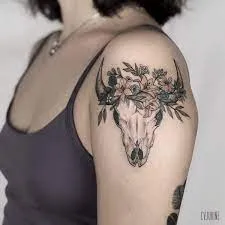
Intriguingly, some Native American tribes attributed tattoos with curative properties. These ancient healers applied tattoos not merely as adornments, but as therapeutic tools. Ink was strategically etched over broken bones and sore joints to stimulate the body’s natural healing energies. It was a fusion of art and medicine, a testament to the deep-rooted connection between body and spirit.
Identity etched in Skin: Tattoos as Status and Accomplishment
Across the diverse landscape of Native American tribes, tattoos were a language of identity. They served as badges of honor, marking significant accomplishments and milestones in an individual’s life. These marks conveyed one’s status within the tribe, revealing a person’s achievements, roles, and responsibilities within their community.
Tattoos Beyond Time: A Continuation of Tradition
The profound legacy of Native American tattoos endures to this day. For individuals of American Indian descent, the tradition lives on. Just as their ancestors did, many proudly wear the art and symbols of their families and tribes, etched onto their skin as a timeless tribute to their roots. In this act, they become living canvases of their heritage, bridging the past and present.
The art of tattooing in Native American culture was a sacred and spiritual practice that transcended mere aesthetics. Tattoos held the power of protection, healing, and identity, reflecting the deep-rooted connection between the physical and the spiritual. Today, this ancient tradition lives on as a symbol of pride, heritage, and a profound link to the past.
